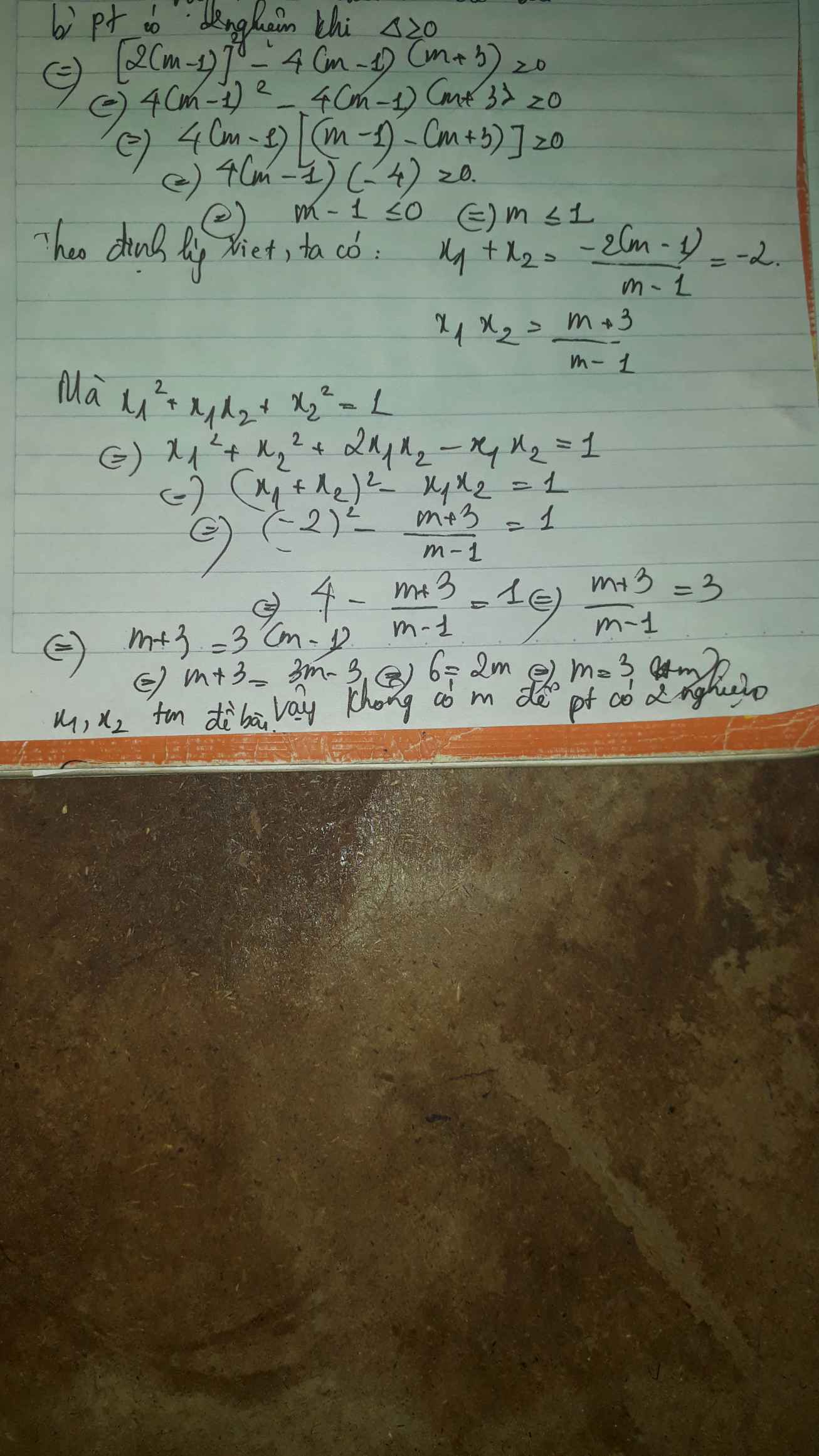Hãy nhập câu hỏi của bạn vào đây, nếu là tài khoản VIP, bạn sẽ được ưu tiên trả lời.

\(\Delta=\left[-2\left(m+1\right)\right]^2-4\left(m^2+4\right)\)
\(=4m^2+8m+4-4m^2-16\)
\(=8m-12\)
Để pt có 2 nghiệm thì \(\Delta>0\)
\(\Leftrightarrow8m-12>0\Leftrightarrow m>\dfrac{3}{2}\)
Theo hệ thức Vi-ét,ta có: \(\left\{{}\begin{matrix}x_1+x_2=2\left(m+1\right)\left(1\right)\\x_1x_2=m^2+4\end{matrix}\right.\)
\(\left(1\right)\rightarrow x_2=2\left(m+1\right)-x_1\)
\(x_1^2+2\left(m+1\right)x_2=3m^2+16\)
\(\Leftrightarrow x_1^2+2\left(m+1\right)\left[2\left(m+1\right)-x_1\right]=3m^2+16\)
\(\Leftrightarrow x_1^2+4\left(m+1\right)^2-2x_1\left(m+1\right)=3m^2+16\)
\(\Leftrightarrow x_1^2+4m^2+8m+4-2x_1\left(m+1\right)=3m^2+16\)
\(\Leftrightarrow x_1^2+m^2+8m-12-2x_1\left(m+1\right)=0\)
\(\Leftrightarrow x_1^2+m^2+8m-12-x_1\left(x_1+x_2\right)=0\)
\(\Leftrightarrow x_1^2+m^2+8m-12-x_1^2-x_1x_2=0\)
\(\Leftrightarrow m^2+8m-12-m^2-4=0\)
\(\Leftrightarrow m^2+8m-16=0\)
\(\Leftrightarrow\left[{}\begin{matrix}m=-4+4\sqrt{2}\left(tm\right)\\m=-4-4\sqrt{2}\left(ktm\right)\end{matrix}\right.\)
Vậy \(m=\left\{-4+4\sqrt{2}\right\}\)

b) phương trình có 2 nghiệm \(\Leftrightarrow\Delta'\ge0\)
\(\Leftrightarrow\left(m-1\right)^2-\left(m-1\right)\left(m+3\right)\ge0\)
\(\Leftrightarrow m^2-2m+1-m^2-3m+m+3\ge0\)
\(\Leftrightarrow-4m+4\ge0\)
\(\Leftrightarrow m\le1\)
Ta có: \(x_1^2+x_1x_2+x_2^2=1\)
\(\Leftrightarrow\left(x_1+x_2\right)^2-2x_1x_2=1\)
Theo viet: \(\left\{{}\begin{matrix}x_1+x_2=-\dfrac{b}{a}=2\left(m-1\right)\\x_1x_2=\dfrac{c}{a}=m+3\end{matrix}\right.\)
\(\Leftrightarrow\left[-2\left(m-1\right)^2\right]-2\left(m+3\right)=1\)
\(\Leftrightarrow4m^2-8m+4-2m-6-1=0\)
\(\Leftrightarrow4m^2-10m-3=0\)
\(\Leftrightarrow\left[{}\begin{matrix}m_1=\dfrac{5+\sqrt{37}}{4}\left(ktm\right)\\m_2=\dfrac{5-\sqrt{37}}{4}\left(tm\right)\end{matrix}\right.\Rightarrow m=\dfrac{5-\sqrt{37}}{4}\)

\(\text{Δ}=\left[-\left(m+1\right)\right]^2-4\cdot1\cdot m\)
\(=\left(m+1\right)^2-4m\)
\(=\left(m-1\right)^2>=0\forall m\)
=>Phương trình luôn có hai nghiệm
Theo Vi-et, ta có:
\(\left\{{}\begin{matrix}x_1+x_2=-\dfrac{b}{a}=m+1\\x_1x_2=\dfrac{c}{a}=m\end{matrix}\right.\)
\(x_1^2+x_2^2=\left(x_1-1\right)\left(x_2-1\right)-x_1-x_2+5\)
=>\(\left(x_1+x_2\right)^2-2x_1x_2=x_1x_2-2\left(x_1+x_2\right)+6\)
=>\(\left(m+1\right)^2-2m=m-2\left(m+1\right)+6\)
=>\(m^2+1=m-2m-2+6\)
=>\(m^2+1=-m+4\)
=>\(m^2+m-3=0\)
=>\(m=\dfrac{-1\pm\sqrt{13}}{2}\)

Cách ngắn ngọn nhất:
x2−2(m+1)x+4m=0(1)�2−2(�+1)�+4�=0(1)
⇔x2−2x−2mx+4m=0⇔�2−2�−2��+4�=0
⇔x(x−2)−2m(x−2)=0⇔�(�−2)−2�(�−2)=0
⇔(x−2)(x−2m)=0⇔(�−2)(�−2�)=0
⇔[x=2x=2m⇔[�=2�=2�
Phương trình (1) có 2 nghiệm là x=2;x=2m�=2;�=2�. Mặt khác phương trình (1) cũng có 2 nghiệm là x1, x2 nên ta chia làm 2 trường hợp:
TH1: x1=2;x2=2m�1=2;�2=2�.
Có 2x1−x2=−2⇒2.2−2m=−2⇔m=32�1−�2=−2⇒2.2−2�=−2⇔�=3
TH2: x1=2m;x2=2�1=2�;�2=2
Có 2x1−x2=−2⇒2.(2m)−2=−2⇔m=02�1−�2=−2⇒2.(2�)−2=−2⇔�=0
Vậy m=0 hay m=3

b1: tìm đk m t/m: Δ>0 ↔ m∈(\(\dfrac{1-\sqrt{10}}{2}\) ; \(\dfrac{1+\sqrt{10}}{2}\))
b2: ➝x1+x2 =-2m-1 (1)
→ x1.x2=m^2-1 (2)
b3: biến đổi : (x1-x2)^2 = x1-5x2
↔ (x1+x2)^2 -4.x1.x2 -(x1+x2) +6.x2=0
↔4.m^2 +4m +1 - 4.m^2 +4 +2m+1+6. x2=0
↔x2= -m-1
B4: thay x2= -m-1 vào (1) → x1 = -m
Thay x2 = -m-1, x1 = -m vào (2)
→m= -1
B5: thử lại:
Với m= -1 có pt: x^2 -x =0
Có 2 nghiệm x1=1 và x2=0 (thoả mãn)

a: Thay m=-5 vào (1), ta được:
\(x^2+2\left(-5+1\right)x-5-4=0\)
\(\Leftrightarrow x^2-8x-9=0\)
=>(x-9)(x+1)=0
=>x=9 hoặc x=-1
b: \(\text{Δ}=\left(2m+2\right)^2-4\left(m-4\right)=4m^2+8m+4-4m+16=4m^2+4m+20>0\)
Do đó: Phương trình luôn có hai nghiệm phân biệt
\(\dfrac{x_1}{x_2}+\dfrac{x_2}{x_1}=-3\)
\(\Leftrightarrow x_1^2+x_2^2=-3x_1x_2\)
\(\Leftrightarrow\left(x_1+x_2\right)^2+x_1x_2=0\)
\(\Leftrightarrow\left(2m+2\right)^2+m-4=0\)
\(\Leftrightarrow4m^2+9m=0\)
=>m(4m+9)=0
=>m=0 hoặc m=-9/4

\(\Delta'=\left(m-1\right)^2+2m=m^2+1>0;\forall m\)
\(\Rightarrow\) Pt luôn có 2 nghiệm pb với mọi m
Theo hệ thức Viet: \(\left\{{}\begin{matrix}x_1+x_2=2\left(m-1\right)\\x_1x_2=-2m\end{matrix}\right.\)
Cộng vế với vế: \(x_1x_2+x_1+x_2=-2\) (1)
\(x_1^2+x_1-x_2=5-2m\)
\(\Leftrightarrow x_1^2+x_1-x_2=5+x_1x_2\) (2)
Cộng vế với vế (1) và (2):
\(\Rightarrow x_1^2+2x_1=3\)
\(\Leftrightarrow x_1^2+2x_1-3=0\Rightarrow\left[{}\begin{matrix}x_1=1\Rightarrow x_2=-\dfrac{3}{2}\\x_1=-3\Rightarrow x_2=-\dfrac{1}{2}\end{matrix}\right.\) (thế \(x_1\) vào (1) để tính ra \(x_2\))
Thế vào \(x_1x_2=-2m\Rightarrow m=-\dfrac{x_1x_2}{2}\Rightarrow m=\pm\dfrac{3}{4}\)

Ta có \(\Delta^'=\left(m-1\right)^2-\left(m^2+1\right)=m^2-2m+1-m^2-1=-2m.\)
Để phương trình đã cho có 2 nghiệm \(x_1,x_2\)thì \(\Delta^'\ge0\Leftrightarrow-2m\ge0\Leftrightarrow m\le0\)
áp dụng hệ thức Vi-et ta có : \(\hept{\begin{cases}x_1+x_2=2\left(m-1\right)\\x_1x_2=m^2+1\end{cases}}\)
Dễ thấy \(x_1x_2=m^2+1\ge1\Rightarrow x_1,x_2\ne0\forall m\)
Khi đó: \(\frac{x_1}{x_2}+\frac{x_2}{x_1}=4\)\(\Leftrightarrow\frac{x^2_1+x_2^2}{x_1x_2}=4\Leftrightarrow\frac{\left(x_1+x_2\right)^2-2x_1x_2}{x_1x_2}=4\)
\(\Leftrightarrow\frac{\left(x_1+x_2\right)^2}{x_1x_2}-2=4\Leftrightarrow\left(x_1+x_2\right)^2=6x_1x_2\)
\(\Leftrightarrow\left(2\left(m-1\right)\right)^2=6\left(m^2+1\right)\Leftrightarrow4m^2-8m+4=6m^2+6\)
\(\Leftrightarrow2m^2+8m+2=0\Leftrightarrow m^2+4m+4=3\Leftrightarrow\left(m+2\right)^2=3\)
\(\Leftrightarrow\orbr{\begin{cases}m+2=\sqrt{3}\\m+2=-\sqrt{3}\end{cases}\Leftrightarrow}\orbr{\begin{cases}m=\sqrt{3}-2\left(TMĐK\right)\\m=-\sqrt{3}-2\left(TMĐK\right)\end{cases}.}\)
Vậy..........